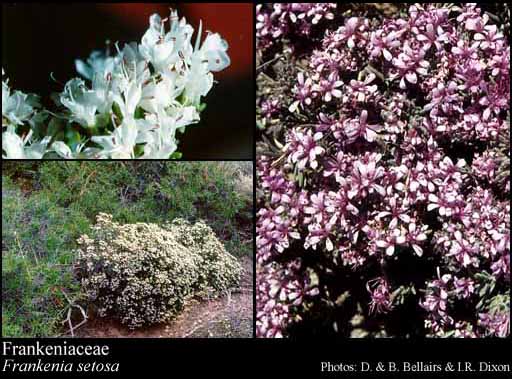- Reference
- Dict.Rais.Bot. p188 (1817)
- Name Status
- Current

Scientific Description
Common name. Frankenia Family.
Habit and leaf form. Sub shrubs, or herbs. Perennial. Xerophytic (and halophytic). Leaves small; opposite (decussate, often ericoid); petiolate; simple; epulvinate. Leaf blades entire; rolled; linear. Leaves without stipules. Leaf blade margins revolute. Leaves without a persistent basal meristem. Stem anatomy. Secondary thickening developing from a conventional cambial ring, or anomalous; when anomalous, via concentric cambia (Frankenia).
Reproductive type, pollination. Fertile flowers hermaphrodite, or hermaphrodite, functionally male, and functionally female. Unisexual flowers present, or absent. Plants hermaphrodite (usually), or polygamomonoecious (occasionally unisexual — Niederlinia). Entomophilous.
Inflorescence and flower features. Flowers solitary, or aggregated in ‘inflorescences’; in cymes. The terminal inflorescence unit cymose. Inflorescences axillary; dichasial. Flowers bracteate; (bi-) bracteolate; regular; cyclic; tetracyclic, or pentacyclic. Perianth with distinct calyx and corolla; 8–14; 2 -whorled; isomerous. Calyx 4–7; 1 -whorled; gamosepalous; shortly blunt-lobed; induplicate valvate; regular; persistent. Corolla 4–7; 1 -whorled; appendiculate (each petal with a scale at the base of the limb, continued down the sides of the claw); polypetalous; imbricate; regular; persistent. Petals clawed. Corolla members bilobed, or fringed. Fertile stamens present, or absent (when flowers female). Androecium (4–)6(–24). Androecial members free of the perianth; all equal, or markedly unequal; more or less coherent; 1 - adelphous (basally connate); 2 -whorled (usually 3+3). Androecium exclusively of fertile stamens. Stamens (4–)6(–24); isomerous with the perianth, or diplostemonous to polystemonous. Anthers versatile; dehiscing via longitudinal slits; extrorse. Fertile gynoecium present, or absent (when flowers male). Gynoecium (2–)3(–4) carpelled. The pistil 1 celled. Gynoecium syncarpous; synstylovarious; superior. Ovary unilocular; 1 locular. The ‘odd’ carpel posterior. Styles 1; apical. Stigmas (2–)3(–4); dry type; papillate; Group II type. Placentation parietal (with (2-)3(-4) 265,2 placentae). Ovules in the single cavity 12–100 (i.e. ‘many’); ascending; non-arillate; anatropous.
Fruit and seed features. Fruit non-fleshy; dehiscent; a capsule. Capsules loculicidal and valvular (enclosed by the calyx). Seeds copiously endospermic. Endosperm not oily (starchy). Seeds with starch. Cotyledons 2. Embryo straight. Seedling. Germination phanerocotylar.
Physiology, biochemistry. Aluminium accumulation not found. Photosynthetic pathway: C3.
Geography, cytology, number of species. World distribution: widespread arid and maritime. X = 10, 15. 90 species.